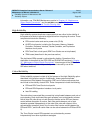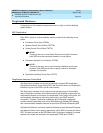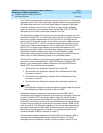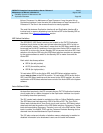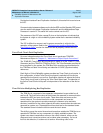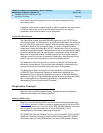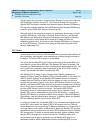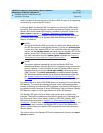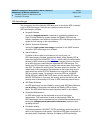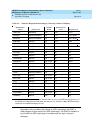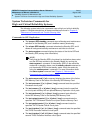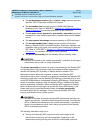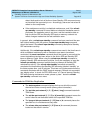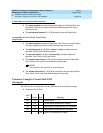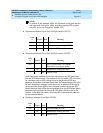
DEFINITY Enterprise Communications Server Release 6
Maintenance for R6vs/si
555-230-127
Issue 1
August 1997
Reliability Systems: A Maintenance Aid
Page 6-10Duplication Concepts
6
readily available to assume the role of the Active SPE, but may do so depending
on the severity of the Active SPE fault(s).
In Busyout Mode, the Standby SPE is busied out by the
busyout SPE-standby
command. Only system technician-requested activities are carried out on the
Standby SPE until a
release SPE-standby
command is executed. Refer to the
status system command in Chapter 8, ‘‘
Maintenance Commands and
Trouble-Clearing Aids’’ for information concerning Standby Modes. Whenever
the Standby SPE is returned to Standby Mode from Maintenance Mode, its
Memory is refreshed.
NOTE:
Verify that the Standby SPE is functional (no duplication alarms exist and
the SPE has returned to the Standby Mode) by running the status system
1 command. If the standby SPE is in the maint/idle mode with no standby
alarms, use the standby refresh command to put the standby SPE into the
standby mode. Verify the results by using the status system 1 command.
For more information about the status system command see Chapter 8,
‘‘Maintenance Commands and Trouble-Clearing Aids’’.
NOTE:
The system software automatically returns the Standby SPE from
Maintenance Mode to Standby Mode at the completion of any maintenance
activity. However, it is also possible to force the Standby SPE to return to
Standby Mode by issuing the refresh spe-standby command from the
G3MT terminal. The refresh spe-standby command preempts Standby
SPE Maintenance Mode except that of entering maintenance mode. See
the ‘‘
System Technician Commands for High and Critical Reliability
Systems’’ section for a description of the refresh spe-standby command.
This means that all of Active SPE DRAM Memory is shadowed over into Standby
SPE Memory. The refresh is necessary because, while in Maintenance Mode,
memory shadowing to the Standby SPE is disabled, and Standby SPE Memory is
not updated to reflect changes in Active SPE Memory. After the refresh, Standby
SPE Memory is again an up-to-date reflection of Active SPE Memory.
The Standby SPE goes into Down Mode when certain error conditions are
detected. These error conditions are described in detail in the "Hardware Error
Log Entries and Test to Clear Values" section of STBY-SPE (Standby SPE)
Maintenance documentation in Chapter 10, ‘‘
Maintenance Object Repair
Procedures’’. Once the error condition(s) that caused the Standby SPE to go into
Down Mode is (are) corrected, the Standby SPE is first put into Maintenance
Mode to conduct testing on Standby SPE components and is then returned to
Standby Mode.
The current mode of the Standby SPE can be determined by issuing the status
system command.




